How to remove the BazarLoader backdoor Trojan from operating systems
TrojanAlso Known As: BazarLoader malware
Get free scan and check if your device is infected.
Remove it nowTo use full-featured product, you have to purchase a license for Combo Cleaner. Seven days free trial available. Combo Cleaner is owned and operated by RCS LT, the parent company of PCRisk.com.
What is the BazarLoader backdoor?
Developed by the same threat actors behind TrickBot, BazarLoader (also known as BazarBackdoor, BazaLoader, BEERBOT, KEGTAP, and Team9Backdoor) is a malicious program classified as a backdoor/loader Trojan. This type of malware opens a "backdoor" to other malicious software. I.e., these Trojans operate by downloading/installing additional malware.
At the time of research, BazarLoader was used to infect compromised systems with RYUK ransomware. BazarLoader malware has been observed being proliferated via spam email campaigns, supposedly containing inside information concerning President Donald Trump's health condition.
The US President's COVID-19 infection diagnosis has been widely used by cyber criminals for malware distribution and phishing purposes.
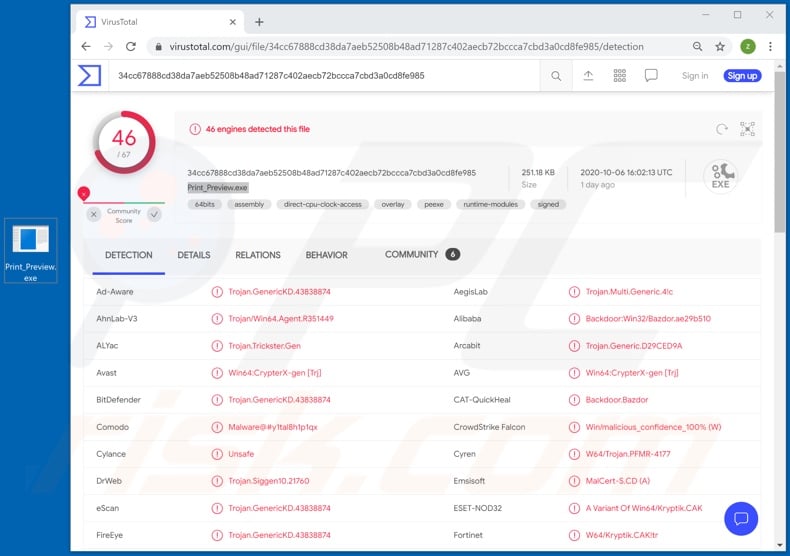
As mentioned, the purpose of BazarLoader is to infect devices with other malicious programs. The type of malware systems can be infected with depends on the cyber criminals' modus operandi and the backdoor/loader itself. This software can inject systems with different types of Trojans, ransomware, cryptominers and other malware.
BazarLoader has been noted infecting affected devices with RYUK ransomware. Malicious programs within this classification operate by encrypting files and/or locking the screen to demand payment (ransoms) for decryption/access recovery. Typically, ransomware renames the encrypted files, however, whether data affected by RYUK is renamed depends on the malware variant.
This malicious program uses RSA-4096 and AES-256 cryptographic algorithms to encrypt files. It creates ransom messages containing decryption instructions, however, specific details (cyber criminals' contact information, ransom size, preferred currency and payment method, etc.) vary from version to version.
Meeting the demands of criminals is not advised, as there are no guarantees that they will hold up their end of any agreement (e.g. send the promised decryption keys/tools, etc.). Removing ransomware from an operating system will prevent it from further encryption, however, removal will not restore already encrypted data.
RYUK or other ransomware is not necessarily the payload that BazarLoader will deliver in all infection cases. Another noteworthy detail concerning the BazarLoader Trojan is its files-less infection process, by which it exploits already existing applications to infect systems, thereby complicating its detection.
If it is suspected or known that the BazarLoader Trojan (or other malware) has already infected the system, use anti-virus software to eliminate it immediately.
| Name | BazarLoader malware |
| Threat Type | Trojan, password-stealing virus, banking malware, spyware. |
| Detection Names | Avast (Win64:CrypterX-gen [Trj]), BitDefender (Trojan.GenericKD.43838874), ESET-NOD32 (A Variant Of Win64/Kryptik.CAK), Kaspersky (Backdoor.Win32.Bazdor.r), Full List (VirusTotal). |
| Payload | RYUK ransomware |
| Symptoms | Trojans are designed to stealthily infiltrate the victim's computer and remain silent, and thus no particular symptoms are clearly visible on an infected machine. |
| Distribution methods | Infected email attachments, malicious online advertisements, social engineering, software 'cracks'. |
| Damage | Stolen passwords and banking information, identity theft, the victim's computer added to a botnet. |
| Malware Removal (Windows) |
To eliminate possible malware infections, scan your computer with legitimate antivirus software. Our security researchers recommend using Combo Cleaner. Download Combo CleanerTo use full-featured product, you have to purchase a license for Combo Cleaner. 7 days free trial available. Combo Cleaner is owned and operated by RCS LT, the parent company of PCRisk.com. |
BLADABINDI, Groooboor, Buer Loader and Upatre are some examples of other malicious programs capable of causing chain infections (i.e. download/installation of additional malware).
This software can have other dangerous capabilities as well, including (but not limited to) file exfiltration, extraction of data from browsers and other applications, keylogging (recording of key strokes), video/audio recording or streaming via compromised webcams/microphones, and so on.
Regardless of how malware operates, the purpose is identical: to generate profit for the threat actors. All malware infections should be treated as highly dangerous and removed without delay.
How did BazarLoader infiltrate my computer?
The BazarLoader Trojan has been spread though spam email campaigns relating to President Trump's health. The term "spam campaign" is used to define a large-scale operation, during which thousands of scam emails are sent.
The deceptive messages proliferating BazarLoader included the following subjects/titles: "Recent material regarding president’s situation", "Recent materials pertaining to the president’s illness", "Newest information regarding president’s condition" and "Newest information pertaining to President’s illness".
Variations and alternatives are likely. The emails suggest that recipients can gain access to "inside information" on Trump's condition by downloading a document via an embedded link.
Once the link is clicked, users are redirected to Google Docs stating that the file is safe, however, rather than downloading a document, a malicious executable is downloaded, which then initiates BazarLoader's infection process/chain.
To elaborate how spam campaigns infect systems, it is generally done via download links in scam emails and/or infectious files attached to the messages. Infectious files can be in different formats such as executables (.exe, .run, etc.), archives (ZIP, RAR, etc.), Microsoft Office and PDF documents, JavaScript, and so on.
Other popular malware distribution techniques are through untrusted download channels, illegal activation tools ("cracks") and bogus updaters. Dubious download sources such as unofficial and free file-hosting websites, Peer-to-Peer sharing networks and other third party downloaders can offer malware for downloading, disguised as or bundled with normal content.
Illegal activation ("cracking") tools can download/install malicious software, rather than activating licensed programs. Fake updaters cause infections by exploiting weaknesses of outdated programs and/or simply by installing malware, rather than the promised updates.
How to avoid installation of malware
To avoid infecting the system with malware spread through spam mail, you are strongly advised not to open suspicious or irrelevant emails, especially those with any attachments or links present in them. Use official and verified download channels.
Additionally, all programs must be activated and updated with tools/functions provided by legitimate developers, since illegal activation tools ("cracks") and third party updaters commonly proliferate malicious software. To ensure device integrity and user safety, it is paramount to have reputable anti-virus/anti-spyware installed and kept updated.
Furthermore, use these programs to run regular system scans and to remove detected/potential threats. If you believe that your computer is already infected, we recommend running a scan with Combo Cleaner Antivirus for Windows to automatically eliminate infiltrated malware.
Screenshot of a scam email, distributing BazarLoader Trojan:
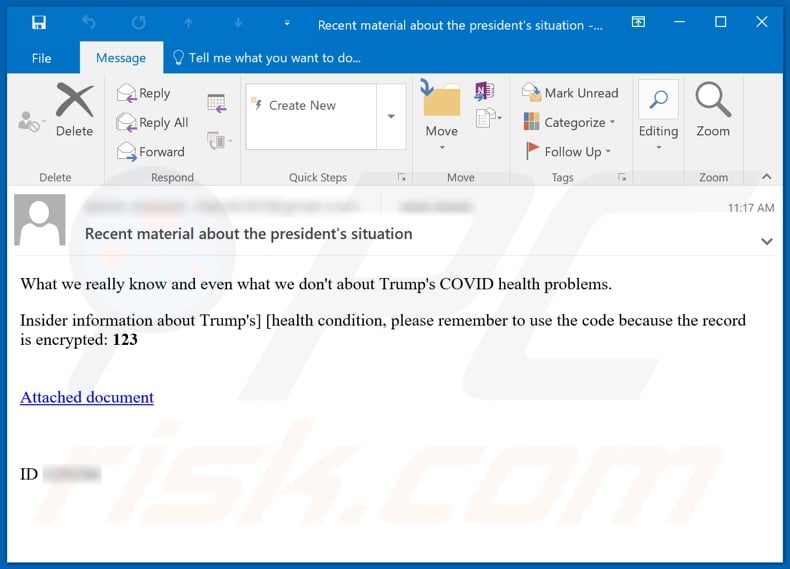
Text presented in this message:
Subject: Recent material about the president's situation
What we really know and even what we don't about Trump's COVID health problems.
Insider information about Trump's] [health condition, please remember to use the code because the record is encrypted: 123
Attached document
ID
A new spam email campaign spreading BazarLoader backdoor has been spotted recently. The emails are presented as invoices from "Rose World". The emails contain a PDF attachment which provides users with links to a malicious Rose World website. The website, in turn, encourages users to download a malicious MS Excel document.
Screenshot of the Rose World website:
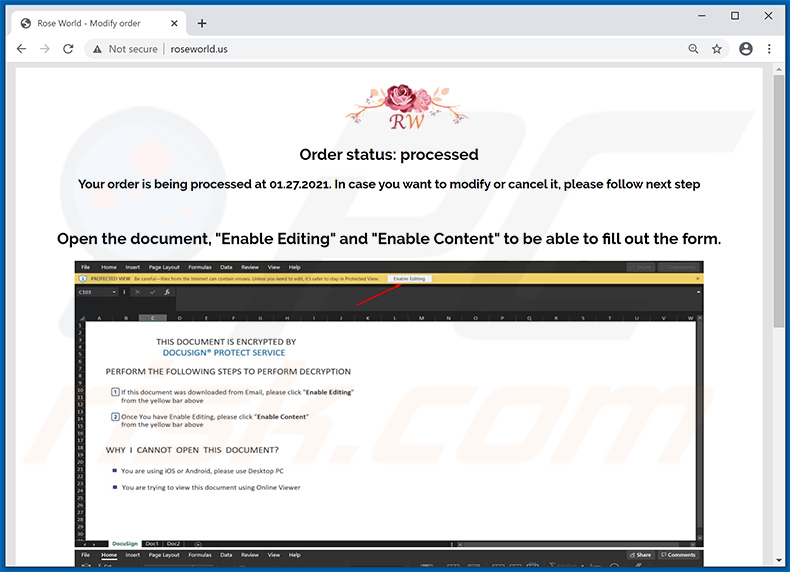
Screenshot of the promoted MS Excel document:
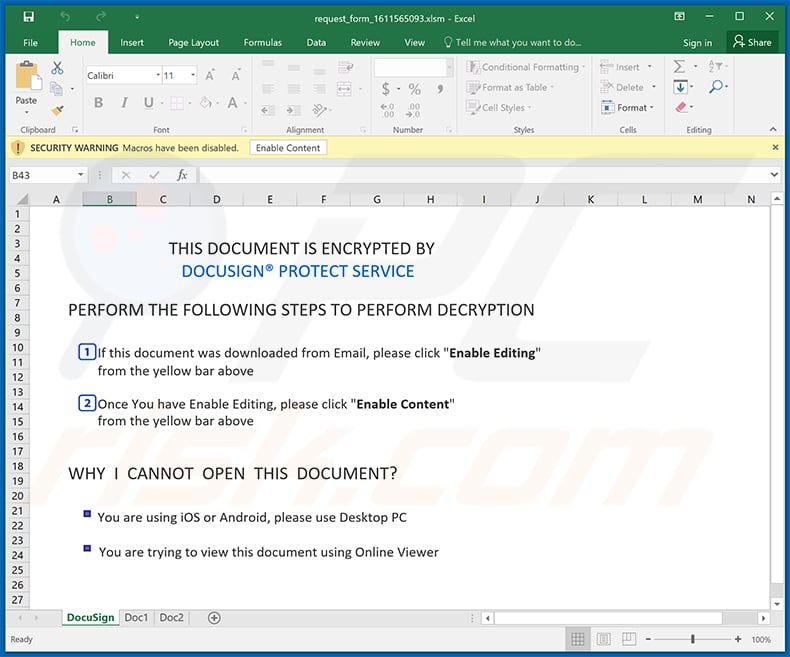
Examples of other malicious MS Excel documents used to spread BazarLoader:
Instant automatic malware removal:
Manual threat removal might be a lengthy and complicated process that requires advanced IT skills. Combo Cleaner is a professional automatic malware removal tool that is recommended to get rid of malware. Download it by clicking the button below:
DOWNLOAD Combo CleanerBy downloading any software listed on this website you agree to our Privacy Policy and Terms of Use. To use full-featured product, you have to purchase a license for Combo Cleaner. 7 days free trial available. Combo Cleaner is owned and operated by RCS LT, the parent company of PCRisk.com.
Quick menu:
- What is BazarLoader?
- STEP 1. Manual removal of BazarLoader malware.
- STEP 2. Check if your computer is clean.
How to remove malware manually?
Manual malware removal is a complicated task - usually it is best to allow antivirus or anti-malware programs to do this automatically. To remove this malware we recommend using Combo Cleaner Antivirus for Windows.
If you wish to remove malware manually, the first step is to identify the name of the malware that you are trying to remove. Here is an example of a suspicious program running on a user's computer:

If you checked the list of programs running on your computer, for example, using task manager, and identified a program that looks suspicious, you should continue with these steps:
 Download a program called Autoruns. This program shows auto-start applications, Registry, and file system locations:
Download a program called Autoruns. This program shows auto-start applications, Registry, and file system locations:

 Restart your computer into Safe Mode:
Restart your computer into Safe Mode:
Windows XP and Windows 7 users: Start your computer in Safe Mode. Click Start, click Shut Down, click Restart, click OK. During your computer start process, press the F8 key on your keyboard multiple times until you see the Windows Advanced Option menu, and then select Safe Mode with Networking from the list.

Video showing how to start Windows 7 in "Safe Mode with Networking":
Windows 8 users: Start Windows 8 is Safe Mode with Networking - Go to Windows 8 Start Screen, type Advanced, in the search results select Settings. Click Advanced startup options, in the opened "General PC Settings" window, select Advanced startup.
Click the "Restart now" button. Your computer will now restart into the "Advanced Startup options menu". Click the "Troubleshoot" button, and then click the "Advanced options" button. In the advanced option screen, click "Startup settings".
Click the "Restart" button. Your PC will restart into the Startup Settings screen. Press F5 to boot in Safe Mode with Networking.

Video showing how to start Windows 8 in "Safe Mode with Networking":
Windows 10 users: Click the Windows logo and select the Power icon. In the opened menu click "Restart" while holding "Shift" button on your keyboard. In the "choose an option" window click on the "Troubleshoot", next select "Advanced options".
In the advanced options menu select "Startup Settings" and click on the "Restart" button. In the following window you should click the "F5" button on your keyboard. This will restart your operating system in safe mode with networking.

Video showing how to start Windows 10 in "Safe Mode with Networking":
 Extract the downloaded archive and run the Autoruns.exe file.
Extract the downloaded archive and run the Autoruns.exe file.

 In the Autoruns application, click "Options" at the top and uncheck "Hide Empty Locations" and "Hide Windows Entries" options. After this procedure, click the "Refresh" icon.
In the Autoruns application, click "Options" at the top and uncheck "Hide Empty Locations" and "Hide Windows Entries" options. After this procedure, click the "Refresh" icon.

 Check the list provided by the Autoruns application and locate the malware file that you want to eliminate.
Check the list provided by the Autoruns application and locate the malware file that you want to eliminate.
You should write down its full path and name. Note that some malware hides process names under legitimate Windows process names. At this stage, it is very important to avoid removing system files. After you locate the suspicious program you wish to remove, right click your mouse over its name and choose "Delete".

After removing the malware through the Autoruns application (this ensures that the malware will not run automatically on the next system startup), you should search for the malware name on your computer. Be sure to enable hidden files and folders before proceeding. If you find the filename of the malware, be sure to remove it.

Reboot your computer in normal mode. Following these steps should remove any malware from your computer. Note that manual threat removal requires advanced computer skills. If you do not have these skills, leave malware removal to antivirus and anti-malware programs.
These steps might not work with advanced malware infections. As always it is best to prevent infection than try to remove malware later. To keep your computer safe, install the latest operating system updates and use antivirus software. To be sure your computer is free of malware infections, we recommend scanning it with Combo Cleaner Antivirus for Windows.
Share:

Tomas Meskauskas
Expert security researcher, professional malware analyst
I am passionate about computer security and technology. I have an experience of over 10 years working in various companies related to computer technical issue solving and Internet security. I have been working as an author and editor for pcrisk.com since 2010. Follow me on Twitter and LinkedIn to stay informed about the latest online security threats.
PCrisk security portal is brought by a company RCS LT.
Joined forces of security researchers help educate computer users about the latest online security threats. More information about the company RCS LT.
Our malware removal guides are free. However, if you want to support us you can send us a donation.
DonatePCrisk security portal is brought by a company RCS LT.
Joined forces of security researchers help educate computer users about the latest online security threats. More information about the company RCS LT.
Our malware removal guides are free. However, if you want to support us you can send us a donation.
Donate
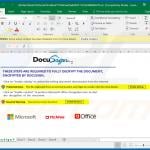
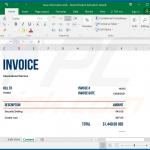
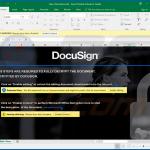
▼ Show Discussion